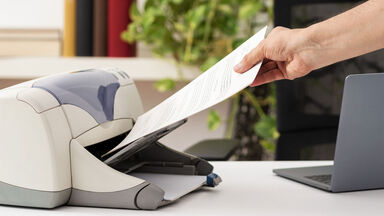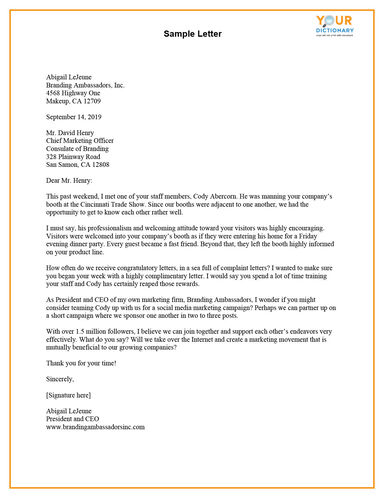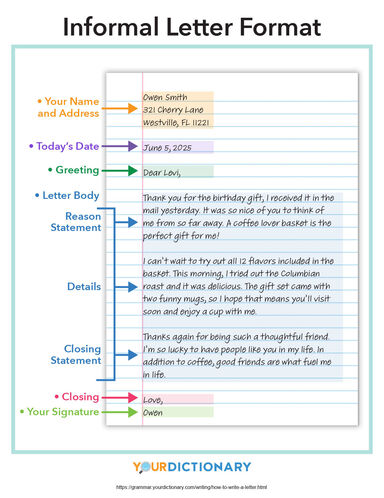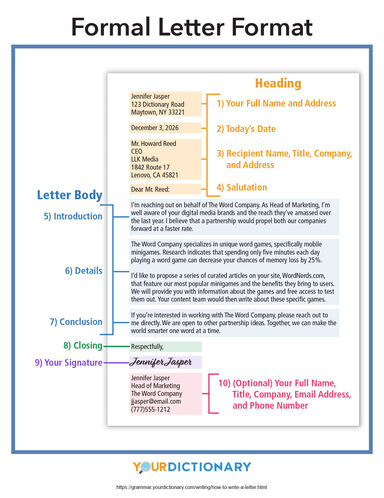How To Write A Letter Writing
How to Write a Letter in Hassle-Free Steps (With Sample)
Knowing how to write a letter, whether business or personal, is a skill that everyone needs. Sometimes, these letters will be short, informal emails. Other times, they'll be highly polished for corporate correspondence. Learn how to write a letter step-by-step, and review a printable sample letter. Then, explore best practices for writing both formal and informal letters.
 letter in printer
letter in printer
Writing a Letter: Step-by-Step
Let's tackle how to write a letter in proper order, from top to bottom. These steps are directed toward a formal letter, though recommended adjustments for informal letters are also included.
- Sender's address - To start, place your full address — including your full name, street address, city, state, and zip code — in the upper left-hand corner. If you're not confident in writing addresses, learn how to write an address properly.
- Date line - Skip a line and specify the date. Use the date the letter is being written.
- Recipient's address - Skip a line and place the recipient's full address. For a formal letter, you'll need to include the company name, the recipient's name and title, and mailing address. For an informal, personal letter, there's no reason to include the company name or job title.
- Greeting/salutation - Skip one more line to insert the greeting. This is called the salutation. In a formal letter, you use "Dear Mr./Ms./Mrs. Last Name:" Formal letters require a colon after the greeting, while informal letters take a comma. For an informal letter, it's fine to use the recipient's first name followed by a comma.
- Body of letter - Skip a line and begin the letter. In the body of your letter, separate your thoughts into paragraphs. You never want to draft one big block of text. For each new set of thoughts or ideas, begin a new paragraph. Leave a blank line between paragraphs.
- Complimentary close - Skip one of your final lines to include a complimentary close. The closing can be as simple as, "Sincerely," "Yours truly," "Regards," or similar. There should always be a comma after the word or phrase you use to close a letter, whether it is formal or informal.
- Signature text - Skip three lines (where you'll insert your handwritten signature), and type your full name. For a formal letter, you should also include your job title on the next line.
- Attachments - If you're including any attachments with your letter, skip one more line and type "Enclosure." If there's more than one attachment, indicate how many there are in parentheses, as in "Enclosures (4)."
For a few more pointers, check out tips on business communication letter writing.
Sample Letter to a Company
Keeping the above formula in mind, the sample letter below illustrates each section of a letter written to a company. Below the sample text, you will find a fully editable PDF that you can use as a template for drafting your own letter.
Abigail LeJeune
Branding Ambassadors, Inc.
4568 Highway One
Makeup, CA 12709September 14, 2019
Mr. David Henry
Chief Marketing Officer
Consulate of Branding
328 Plainway Road
San Samon, CA 12808Dear Mr. Henry:
This past weekend, I met one of your staff members, Cody Abercorn. He was manning your company's booth at the Cincinnati Trade Show. Since our booths were adjacent to one another, we had the opportunity to get to know each other rather well.
I must say, his professionalism and welcoming attitude toward your visitors was highly encouraging. Visitors were welcomed into your company's booth as if they were entering his home for a Friday evening dinner party. Every guest became a fast friend. Beyond that, they left the booth highly informed on your product line.
How often do we receive congratulatory letters, in a sea full of complaint letters? I wanted to make sure you began your week with a highly complimentary letter. I would say you spend a lot of time training your staff and Cody has certainly reaped those rewards.
As President and CEO of my own marketing firm, Branding Ambassadors, I wonder if you might consider teaming Cody up with us for a social media marketing campaign? Perhaps we can partner up on a short campaign where we sponsor one another in two to three posts.
With over 1.5 million followers, I believe we can join together and support each other's endeavors very effectively. What do you say? Will we take over the Internet and create a marketing movement that is mutually beneficial to our growing companies?
Thank you for your time!
Sincerely,
[Signature here]
Abigail LeJeune
President and CEO
www.brandingambassadorsinc.com
Printable Sample Letter Template
The template below is provided as a resource to help you format your own letter. You can save or print it for future reference. You can even edit the document once you open it, so you can customize it for your needs.

View & Download PDF
Format Considerations for Different Types of Letters
Letters can be either informal or formal. Both types are similar in terms of format, but there are some differences. Informal or personal letters may come in the form of email, but the basic premise remains the same.
Informal/Personal Letter Best Practices
It is important to know how to write a letter of a personal nature. Personal letters are not as formal as business letters and can be handwritten or typed. The tone can be conversational, even using a bit of slang or colloquial terminology.
- For the greeting, use an informal salutation (first name only) ending with a comma in lieu of a colon.
- In the body, the first paragraph is usually an introduction setting out the reason you are writing.
- The next paragraphs go into more detail. The closing paragraph summarizes what you've had to say. You may want to thank the recipient or ask questions.
- The closing comes after two skipped lines and can also be informal.
- If you want to add a P.S. or P.P.S. to your personal letter, skip another line and start the P.S. on the left-hand side of the paper.
If you are sending a hand-written letter or an email, the mailing addresses don't have to be included.

View & Download PDF
Formal Letter Best Practices
Formal letters follow a set pattern, as you can see in the example above. One type of formal letter that will be an important part of most people's lives is the cover letter. In a cover letter, as with all business letters, you'll need to use a standard formal letter format.
- A cover letter should generally include three body paragraphs. The first paragraph explains why you are writing, what position you want, and why you want it. The second outlines why you are the best person for the job and summarizes your skills and experience.
- The closing paragraph mentions your resume and asks for an interview. You need to be strong and upbeat in this paragraph so the reader will want to interview you.
- Thank the person for his time and include contact information.
Follow a similar structure with all business letters and other formal letters, adapting as needed based on the purpose for which you are writing. If you're sending a formal letter in the body of an email, the addresses aren't necessary.

View & Download PDF
General Writing Tips
Now that you know the steps involved in writing a letter and have had an opportunity to review best practices for both formal and informal letters, you're just about ready to write a letter of your own. With the general steps listed above in mind, consider a few key tips:
- Know your audience. Only use technical terms or industry jargon if you are sure the reader will understand.
- Avoid contractions in formal letters, as with all business writing. It is fine to use contractions in informal letters.
- Keep letters relatively short if at all possible. Do not write two (or more) pages if one will do.
- Be clear and to the point with your message. Use specific language that leaves no room for misunderstanding.
- Leave out unnecessary details. As you re-read your letter for accuracy, ask yourself if anything in there is unnecessary information.
- Remain professional. Do not include any inappropriate language or use an unpleasant tone, even if you are writing a complaint letter or a letter of resignation.
Written Communication Skills
Now that you know the basics of letter writing, explore examples of letters and what to include in them for more advice and samples of different styles of letters. Then, discover what P.S. stands for at the end of a letter and how to use it.
Written communication is an important skill to list on a resume. More than that, knowing how to write a letter is an important skill that you will use throughout your life, for both personal and professional reasons. Learn more about what's involved in effective written communication.
How To Write A Letter Writing
Source: https://grammar.yourdictionary.com/writing/how-to-write-a-letter.html
Posted by: jordanfriess50.blogspot.com

0 Response to "How To Write A Letter Writing"
Post a Comment